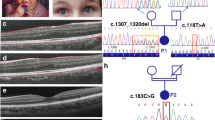Abstract
ACCORDING to Gates1 the frequency of pure albinos is about 1 in 15–25,000 of the population in Scotland. Owing to the kindness of Miss E. C. MacQuade, an albino woman aged about 45–50 years was brought for colour vision tests. She was a pure albino, according to Gates's classification, having cream-white hair, eyebrows and eyelashes, and only a very slight trace of pigment in the iris. She had a continuous nystagmus owing to photophobia, and a divergent squint, for the same reason, using mainly the left eye while the unused eye wandered. She was very shortsighted. Her mother had fifteen children, seven boys and eight girls. She and a younger sister, now deceased, were the only albinos known among all her relations.
This is a preview of subscription content, access via your institution
Access options
Similar content being viewed by others
References
Gates, R. R., “Human Genetics”, Chapter 9 (1946).
Pickford, R. W., “Individual Differences in Colour Vision”, Chapter 9 (1951).
Author information
Authors and Affiliations
Rights and permissions
About this article
Cite this article
PICKFORD, R. Colour Vision of an Albino. Nature 168, 954 (1951). https://doi.org/10.1038/168954a0
Issue date:
DOI: https://doi.org/10.1038/168954a0
This article is cited by
-
Color vision in albino subjects
Documenta Ophthalmologica (1983)
-
Colour Vision of Three Albinos
Nature (1958)
-
Spektrale Sensitivit�t und Blutreflexion
Pfl�gers Archiv f�r die Gesamte Physiologie des Menschen und der Tiere (1958)



